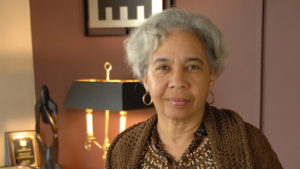Detroit: A City Built on Humanities
By Sydney Boyd (no relation to Dr. Melba Boyd)
This interview occurred before the National Humanities Conference was canceled. We spoke with the intent of spotlighting the unique significance of bringing humanities leaders together in Detroit, and even though we won’t be meeting there, we continue to think about the rich and instructive history of the city.
 When Dr. Melba Boyd thinks of Detroit’s evolution as a city, she sees a deep and complex history. “Detroit is one of the oldest cities in North America,” Boyd told me.
When Dr. Melba Boyd thinks of Detroit’s evolution as a city, she sees a deep and complex history. “Detroit is one of the oldest cities in North America,” Boyd told me.
Distinguished University Professor in African American Studies at Wayne State University and Adjunct Professor in the Department of Afroamerican and African Studies at the University of Michigan, Boyd sees the humanities as playing a specific and significant role in the city’s evolution. In turn, she notes, looking at that development also helps us understand changing perceptions of the humanities at large.
“The humanities have grown in concept in educational institutions,” Boyd said. “Before, it was limited to sort of a Western civilization idea of what the humanities is, and it’s grown beyond that. Detroit is a great place to consider that because of the amount of cultural production that has gone on here.”
Boyd has been a part of Detroit’s cultural development over many decades; you’ll find one of her poems inscribed on the wall of the Charles H. Wright Museum of African American History—the official poem of the museum, which she wrote in 1997 and counts as her “greatest achievement as a poet.” Boyd grew up in Detroit in the 1950s. Her parents moved there from Alabama following her grandparents, who had taken up residence as part of the Second Great Migration during World War II when about five million African Americans migrated north and west from the south.
“A lot of Black people came to Detroit in hopes of opportunities that they were not going to be able to get [in the south]” Boyd said. “It was one of the best places, certainly after World War II, for Black people to live…people were gaining some strengths and some control over their political and social circumstances—it wasn’t like some paradise by any stretch of the imagination, but there was more opportunity for growth and for planning than in a lot of other areas in the United States.”
With opportunity came better-paying jobs and more fluid income in the community, Boyd told me, which meant more possibilities for institutional and cultural growth.
“We had Black bookstores, you know, and even if the mainstream bookstores weren’t interested in carrying the books, we had our own bookstores, and people had money to buy books with,” Boyd said. “You have that dynamic occurring where when you have access, opportunity, and you have fun—you can do a lot.”
Boyd noted Berry Gordy and Diana Ross as just two examples of many cultural leaders who benefitted from educational opportunities specific to the city—albeit not in the same way. Gordy learned about business operations as a factory worker before founding Motown Records, Boyd explained; Ross, who would later become one of Motown’s greatest legends, took singing classes at Cass Technical High School. Detroit is also home to Boone House, where foundational African American writers like Naomi Long Madgett, Dudley Randall, Margaret Danner, and Oliver LaGrone gathered regularly.
“Its history is very complex, possibly because the people who live here are not always regarded as, you know, mainstream Americans,” Boyd said. “But this has certainly had a big influence on what makes the area distinct and certainly in terms of the cultural richness of it.”
Boyd described Detroit as a very complicated place historically, demographically, and ethnically, not least because it sits right on the US-Canadian border. There’s a strong Latino community, a long history of Polish-American neighborhoods, and it boasts one of the largest Arab American populations in the United States, Boyd said.
“You can see how all these different cultures are quilted into the fabric of the metro area and also how we’ve interacted and grown together, and we actually have institutions here that are not just narrowly defined by a particular group—we work together,” Boyd said.
Photo credit: Wayne State University, Department of African American Studies.


